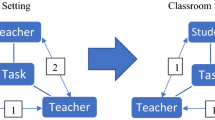Abstract
This paper follows up our theoretical discussion of the potential for collaborative problem solving in Design and Technology (Hennessy and Murphy, 1999). In this paper we report our empirical investigation of peer collaboration in a setting where we identified the presence of significant pre-conditions for productive collaboration. The study investigated the participation of two boys aged 13 who worked together with their teacher over 8 weeks in designing and making an aid for a child with a disability. We analysed their participation using a framework of key features derived from the research literature.
Our analyses yielded evidence of effective collaboration in the early design stage, but the students' collaboration and their progress were subsequently undermined. The reasons related to the students' ability to collaborate and the tension for the teacher between students' learning needs and client needs within an authentic activity. The outcome was a successful product but a wealth of lost opportunities – and lack of support – for the students' collaborative problem solving and Design and Technology (D&T) learning. Our observations confirm that despite little evidence of collaboration in D&T, this setting offers extensive resources for supporting collaboration in joint design, planning and problem-solving activities. We also identify impediments to collaboration as a learning mechanism.
Similar content being viewed by others
REFERENCES
Azmitia, M.: 1988, 'Peer Interaction and Problem Solving: When Are Two Heads Better Than One?’, Child Development 59, 87-96.
Barlex, D.: 2000, Young Foresight: Shaping Things to Come. Handbook for Teachers and Mentors, Software Production Enterprises, London.
Bruner, J.S.: 1996, The Culture of Education, Harvard University Press, Cambridge, MA.
Bucciarielli, L.: 1988, 'An Ethnographic Perspective on Engineering Design’, Design Studies 9(3), 159-168.
Cross, N., Christiaans, H. and Dorst, K.: 'Design Expertise Amongst Student Designers’, Journal of Art and Design Education 13(1), 39-56.
Department of Education and Science and the Welsh Office DES/WO: 1990, Technology in the National Curriculum, HMSO, London.
Greeno, J.G.: 1993. The Situativity of Learning: Prospects for Synthesis in Theory, Practice and Research (mimeograph), Institute for Research on Learning, Stanford University, Palo Alto.
Hennessy, S. and Murphy, P.: 1999, 'The Potential for Collaborative Problem Solving in D&T’, International Journal of Technology and Design Education 9(1), 1-36.
Lave, J.: 1988, Cognition in Practice: Mind, Mathematics and Culture in Everyday Life, Cambridge University Press, Cambridge.
Lave, J.: 1992, 'Word Problems: A Microcosm Of Theories Of Learning’, in P. Light and G. Butterworth (eds.), Context and Cognition: Ways of Learning and Knowing, Harvester Wheatsheaf, London.
Lyle, S.: 1996, 'An Analysis of Collaborative Group Work in the Primary School and the Factors Relevant to its Success’, Language and Education 10(1), 13-32.
McCormick, R., Murphy, P. and Davidson, M.: 1994, 'Design & Technology as Revelation and Ritual’, in J. S. Smith (ed.), IDATER 94, International Conference on Design and Technology Educational Research and Curriculum Development, pp. 38-42, Department of Design & Technology, Loughborough University of Technology.
McCormick, R., Murphy, P., Hennessy, S. and Davidson, M.: 1996, Problem solving in Design and Technology: A case of situated learning? Final Report to ESRC (R000234458).
Medway, P.: 1994, 'The Language Component in Technological Capability: Lessons From Architecture’, International Journal of Technology and Design Education 4(1), 85-107.
Medway, P.: 1996, 'Virtual and Material Buildings: Construction and Constructivism in Architecture and Writing’, Written Communication 13(4), 473-514.
Mercer, N.: 1995, The Guided Construction of Knowledge: Talk Amongst Teachers and Learners, Multilingual Matters, Clevedon.
Moschkovich J.: 1996, 'Moving Up and Getting Steeper: Negotiating Shared Descriptions of Linear Graphs’, The Journal of the Learning Sciences 5(3), 239-277.
Murphy, P.: 1999, 'Supporting Collaborative Learning: A Gender Dimension’, in P. Murphy (ed.), Learners, Learning and Assessment, Paul Chapman, London.
Murphy, P., Davidson, M. and Lunn, S.: 2001, Young Foresight, Phase 1 Evaluation: Interim Summary Report, Software Production Enterprises, London.
Newman, D., Griffin, P. and Cole, M.: 1989, The Construction Zone: Working for Cognitive Change in School, Cambridge University Press, Cambridge.
Rogoff, B.: 1995, 'Observing Sociocultural Activity on Three Planes: Participatory Appropriation, Guided Participation, and Apprenticeship’, in J. V. Wertsch, P. Del Rio and A. Alvarez (eds.), Sociocultural Studies of Mind, Cambridge University Press, Cambridge.
Rogoff, B.: 1997, 'Cognition As a Collaborative Process’, in D. Kuhn and B. Siegler (eds.), Handbook of Child Psychology, Vol. 2: Cognition, Perception and Language, John Wiley & Sons, New York.
Vygotsky, L.S.: 1978, Mind in Society: The Development of Higher Psychological Processes, Harvard University Press, Cambridge, MA.
Author information
Authors and Affiliations
Rights and permissions
About this article
Cite this article
Murphy, P., Hennessy, S. Realising the Potential – and Lost Opportunities – for Peer Collaboration in D&T Setting. International Journal of Technology and Design Education 11, 203–237 (2001). https://doi.org/10.1023/A:1011286331859
Issue Date:
DOI: https://doi.org/10.1023/A:1011286331859




